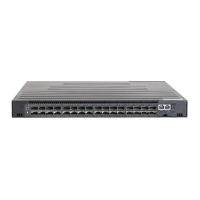C
HAPTER
14
| Basic Administration Protocols
Remote Monitoring
– 475 –
CONFIGURING
RMON EVENTS
Use the Administration > RMON (Configure Global - Add - Event) page to
set the action to take when an alarm is triggered. The response can include
logging the alarm or sending a message to a trap manager. Alarms and
corresponding events provide a way of immediately responding to critical
network problems.
CLI REFERENCES
◆ "Remote Monitoring Commands" on page 793
COMMAND USAGE
◆ If an alarm is already defined for an index, the entry must be deleted
before any changes can be made.
◆ One default event is configured as follows:
event Index = 1
Description: RMON_TRAP_LOG
Event type: log & trap
Event community name is public
Owner is RMON_SNMP
PARAMETERS
These parameters are displayed:
◆ Index – Index to this entry. (Range: 1-65535)
◆ Type – Specifies the type of event to initiate:
■
None – No event is generated.
■
Log – Generates an RMON log entry when the event is triggered.
Log messages are processed based on the current configuration
settings for event logging (see "System Log Configuration" on
page 418).
■
Trap – Sends a trap message to all configured trap managers (see
"Specifying Trap Managers" on page 463).
■
Log and Trap – Logs the event and sends a trap message.
◆ Community – A password-like community string sent with the trap
operation to SNMP v1 and v2c hosts.
Although the community string can be set on this configuration page, it
is recommended that it be defined on the SNMP trap configuration page
(see "Setting Community Access Strings" on page 457) prior to
configuring it here. (Range: 1-127 characters)
◆ Description – A comment that describes this event. (Range: 1-127
characters)
◆ Owner – Name of the person who created this entry. (Range: 1-127
characters)

